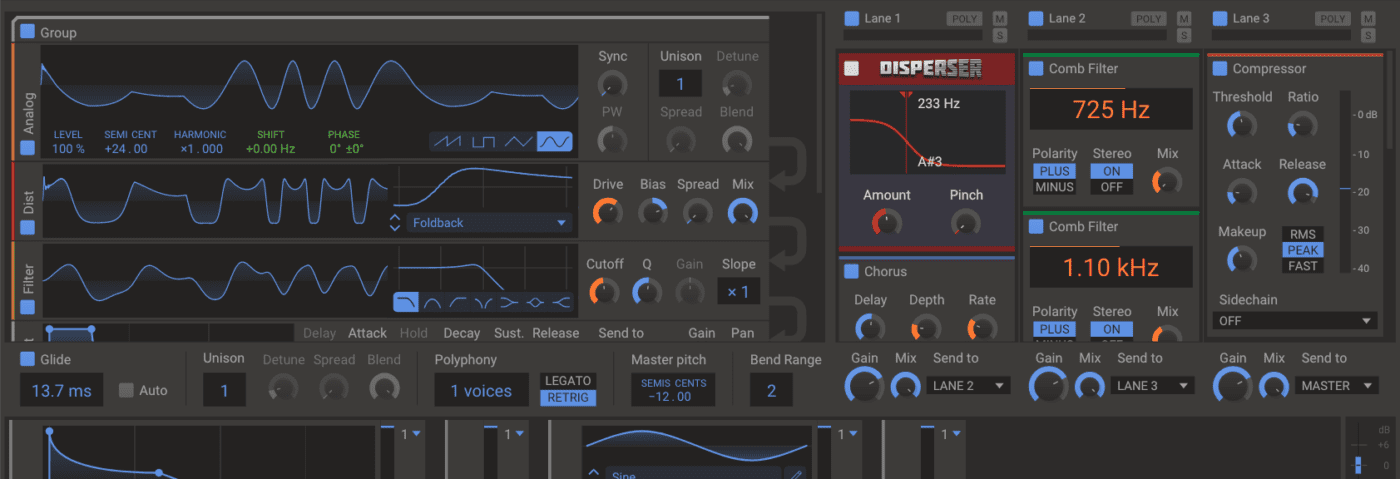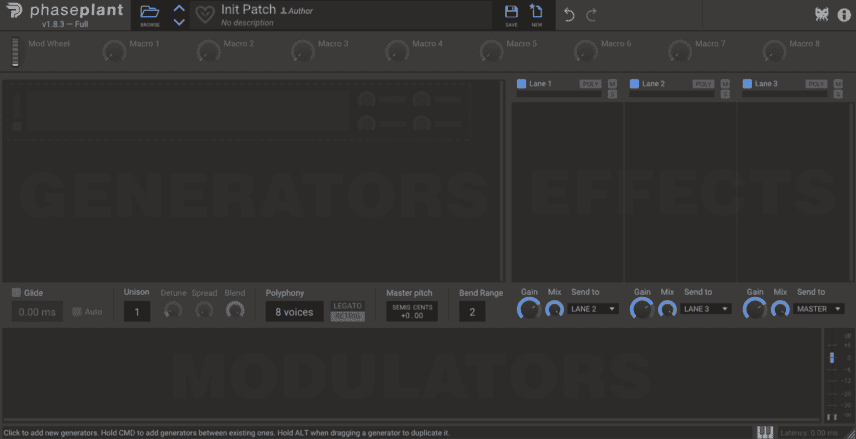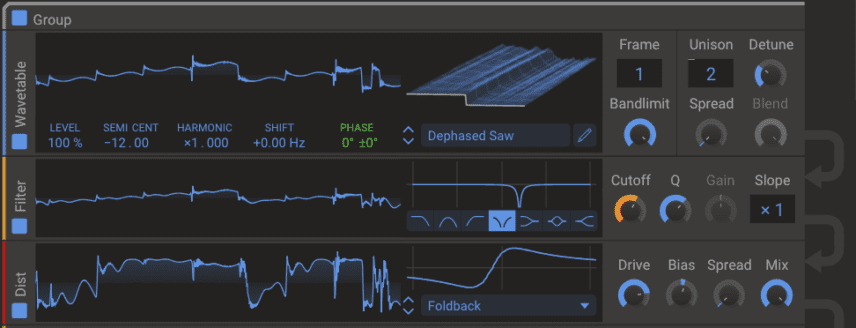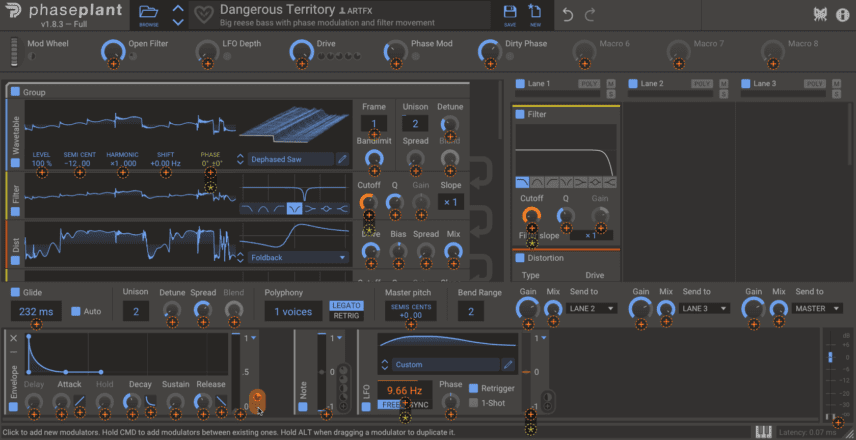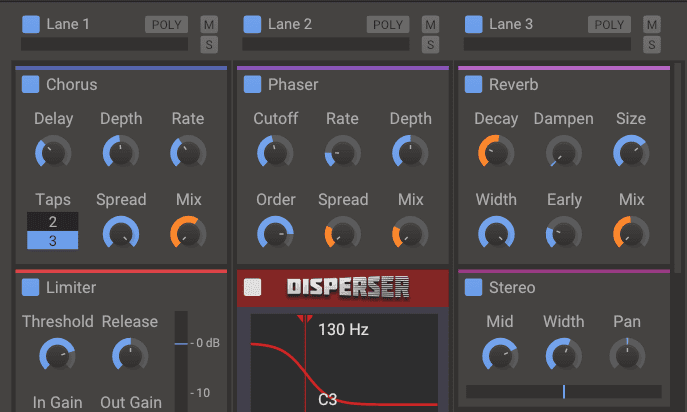What do you get when you combine sound generators like wavetables, samples, and virtual analogue waveforms with FM, multiple lanes of effects, extreme modulation, and a customizable modular environment? You get Phase Plant, Kilohearts’ supremely flexible synthesizer plugin.
With so many excellent soft synths on the market today, it takes more than just a couple of wavetable oscillators and a big reverb to make an impression. Phase Plant, Kilohearts’ flagship synth, does indeed have wavetable oscillators and a nice reverb, but it has so much more than that. Aside from a number of different sound generators, modulation sources, and an expandable effects section, Phase Plant is, at its heart, a modular synthesizer, though perhaps not the kind that immediately comes to mind. Instead of connecting immovable modules together with cables, Phase Plant allows you to slot modules in where needed and, as with rack-style modular synths, flexibility becomes a key element in sound design.
It Starts With An Empty Rack
To get a an idea of how Phase Plant functions, let’s look at how sounds are made. Every time you open an instance of the synth you’re greeted with an empty rack. There are three main sections for modules: sections for sound generators, modulators, and effects.
There are four sound generators in Phase Plant which can combine to create a hybrid synthesis: wavetable, analogue, sampled-based, and noise. The wavetable section is the heart of Phase Plant’s sound generators. It comes loaded with plenty of wavetables, and users can import samples to use as new tables or even draw in their own. As with Arturia’s Pigments 2, there’s also a virtual analogue section. Phase Plant’s has four waveforms available, sawtooth, pulse, triangle, and sine, and users can change (and modulate) a number of parameters, such as phase and shift. There’s also oscillator sync and pulse width. The sample player can load samples, either from those that come bundled with the software or from the user’s own collection. Three types of noise round out the sound generators.
Within the sound generator section, there are also envelopes, filters, distortion, and utility tools like mixers and group frames. Yes, we said distortion. Including distortion at the sound generation level can make a big difference in sound. Group frames are convenient too, as sound generators can be combined and grouped as you see fit. Any sound generator can also act as a modulator, meaning you could use a sample to modulate the frame position of a wavetable or the phase of a sawtooth. The modulation possibilities are staggering and this is part of what makes Phase Plant such a powerful piece of software.
Next we have the modulator section, with your usual complement of envelopes, LFOs (with one-shot and retrigger modes), random waves for sample and hold-style modulation, plus MIDI and utility modules. To assign modulation, just click the plus button on the module and available destinations will all light up. Easy and intuitive.
Next, let’s look at the effects. The effects section is incredible, with three lanes open to host Kilohearts’ remarkable selection of snapin effects. The catch is unless you’ve already invested in these, you’ll only have six basic effects to work with, although all will appear in presets as fully functioning yet uneditable versions. Modulation extends to effects as well and really contributes to the richness and depth of sound of the plugin, especially in poly mode, which sends each unique synth voice separately through the chain.
Lastly, there are eight macros across the top for adjusting multiple parameters at the same time, useful for programming risers and transitions.
The Sound Is Everything
With so many modulation destinations, and even sound generators able to be modulators, Phase Plant can produce sounds with an incredible amount of movement. Think evolving pads, twisting and churning effects, and modulating basses. Bass seems to be something of a speciality of Phase Plant. A quick look at the presets will reveal three different folders for bass sounds, with drum and bass-style reeses occupying a big chunk of the Bass Hard set. The plugin also has a lot of future bass sounds, classic dance bass, and plenty more.
Of course, you’re not restricted to just wild and woolly patches. Phase Plant can do your usual leads, keys and polys as well, and, thanks to its audio rate frequency modulation, it is just as comfortable with FM-style mallets and plucks too.
While the sound is often breath-taking, we didn’t fall in love with the GUI. Although easy to read and understand, the multiple lanes and nested sections can make more complex patches a little unwieldy, even with collapsible nested groups. A little more colour would not have gone amiss either, with the black and grey palette making it all a little samey.
The Verdict
Phase Plant stands in a crowded field. Its closest competition is likely Native Instruments’ wavetable-powered Massive X ($199), which also has a modular section, although the implementation is more like Reaktor than Phase Plant’s rack system. Arturia Pigments 2 ($199) similarly offers multiple sound-generation sources (virtual analogue, sample-based, and granular along with wavetable) and throws a sequencer in for good measure, something that we’d like to see implemented in a future version of Phase Plant as well. At $169, Phase Plant is competitively priced, although to get the most of its effects section you already have to be a snapin user, or pony up for a Toolbox bundle or subscription.
Although Phase Plant’s presets sound great, particularly for bass music genres, at its heart it’s a modular system, and modular systems reward experimentation. If sound design is your thing, or if you’ve been wanting to dip your toes into the modular pool, Phase Plant is an incredible way to generate new and unheard sounds no matter the genre of music you make. And, unlike some modular systems, there’s a relatively low learning curve, meaning you’ll be spending your time creating rather than figuring out how to create. Powerful, inspiring, and intuitive—it’s not often a synthesizer can be all three. Phase Plant is all this and more.
